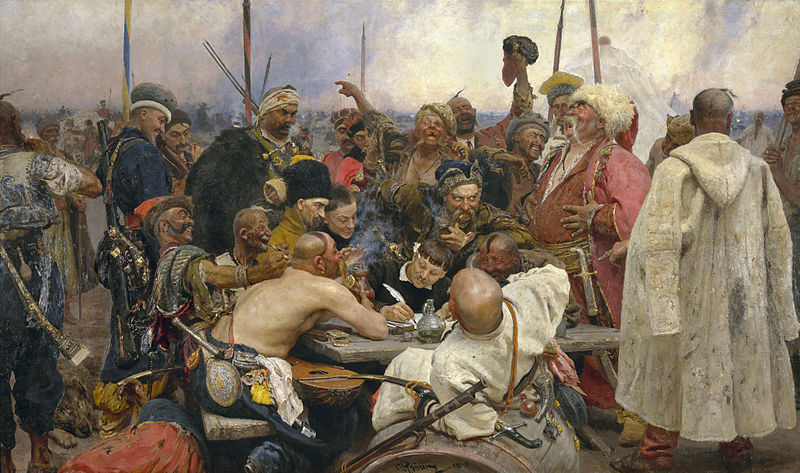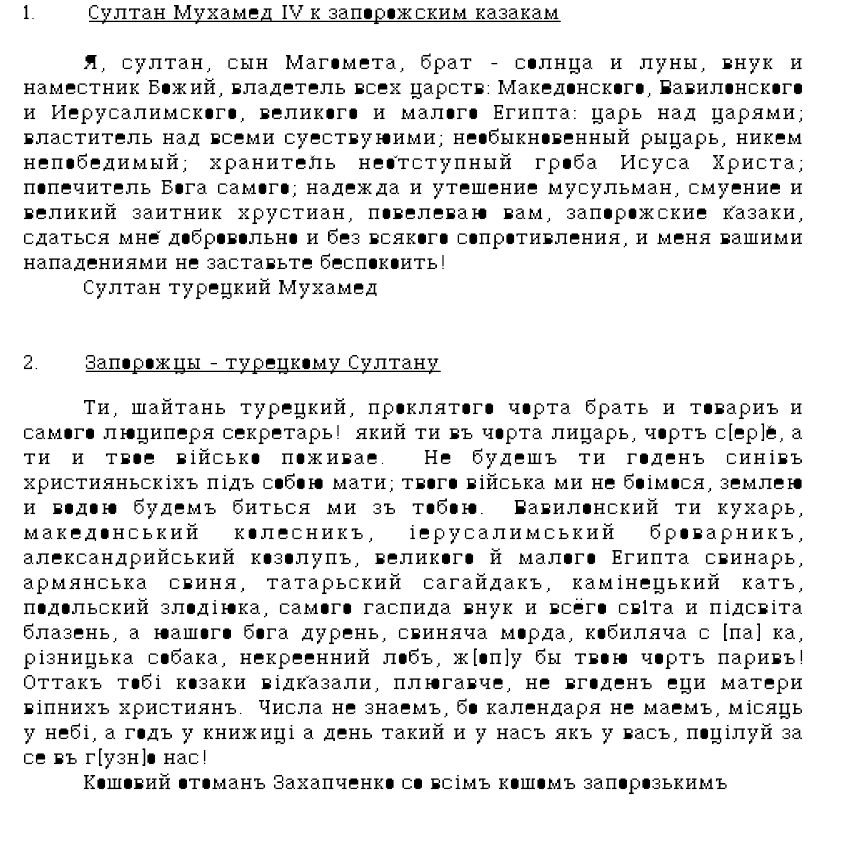The Rudest Diplomatic Letter Ever Written? May 10, 2015
Author: Beach Combing | in : Modern , trackback
***Thanks to Chris from Haunted Ohio Books for putting me onto this story***
There are many uncertainties about the letters that follow, so let’s give the orthodox version, then the letters themselves and move on from there. In the 1670s the Sultan of the Ottoman Empire in cooperation with the Khan of the Crimea decided to try and put the harness on a group of hooligans remembered by history as the Horde of the Zaporozhians in Ukraine. These were Cossack Steppe warriors: in modern terms, and sorry to any romantic Slav nationalists out there, this was the equivalent of the city police closing down a biker club on the edge of town. In the 1670s, and our best study dates, though with practically no proof, the letter to 1672-1680, the Ottoman Empire sent a message to the Horde telling them that they better give up or else: to carry on with the slightly involved metaphor from above, this was the police constable riding up on his cycle to give One-Eyed Jack, head of the gang a polite warning. The letter was as follows: note that the two translations below come from Friedman’s short linguistic analysis of the relevant texts (Slavica Hierosolymitan 1978), with though abbreviations spelt out for ease of reading.
I, the Sultan, son of Mohamed, brother of the Sun and Moon, grandson and vicegerent of God, sovereign of all kingdoms: of Macedonia, Babylonia, and Jerusalem, of Upper and Lower Egypt: king of kings; ruler of all that exists; extraordinary, invincible knight; constant guardian of the grave of Jesus Christ; trustee of God himself; hope and comport of Moslems, confusion and great protector of Christians, command, the Zaporohian Cossacks, to surrender to me voluntarily and without any kind of resistance, and don’t permit yourselves to trouble me with attacks! Turkish Sultan Mehmed.
At this point the Zaporzhians who didn’t really do ‘surrender’ decided to have some fun.
Zaporozhians – to the Turkish Sultan. You Turkish Satan, brother and comrade of the damned devil and secretary to Lucifer himself! What the hell kind of knight are you? The devil shits and you and your army swallow it. You aren’t fit to have the sons of Christians under you; we aren’t afraid of your army, and we’ll fight you on land and sea. You Babylonian busboy, Macedonian mechanic [nasty!], Jerusalem beer-brewer, Alexandrian goatskinner, swineherd of Upper and Lower Egypt, Armenian pig, Tatar goat, Kamenets hangman, Podolian thief, grandson of the Evil Serpent himself, and buffoon of all the world and the netherworld, fool of our God, swine’s snout, mare’s asshole, butcher’s dog, unbaptized brow, may the devil steam [?] your ass! That’s how the Cossacks answer you, you nasty glob of spit! You’re unfit to rule true Christians. We don’t know the date because we don’t have a calendar, the moon [i.e. month] is in the sky, and the year is in the book, and the day is the same with us as with you, so go kiss your butt. Chief Hetman Zaxarcenko with all the Zaporozhian Host
This is wonderful stuff, and in the late nineteenth-century the Ukrainian painter Repin spent ten years trying to portray the writing of the insulting letter. The painting is at the head of the post and transcends the normally unconvincing and earnest quality of history compositions from the 1800s: click in to enjoy the quality of the laughter. The painting was bought by the Tsar for a record sum and later a copy hung in Stalin’s office: it was said to be his favourite and he learnt, allegedly, the insults by heart.
However, now the awkward question: are these two letters genuine? In the only extensive study in English Friedman avoids the question by saying that the letters are apocryphal: in other words if they are not the genuine article they represent some kind of historical truth. This is a complete cop out. As it happens there is no original document that has been found in Ukraine (no surprise) or rather more curiously in the Ottoman archives (such as they are). What is worse there are three nineteenth-century versions, of which Beach has published above the most obscene (and perhaps for that reason the most credible). Its language is also the most Ukrainian (as opposed to Russian): obviously this is taken on trust from hairy philologists, the present blogger is not a Slavist. This version was also the earliest published, 1872. Beach does not know if anyone has a scrap of paper somewhere that could be dated back any earlier than this…
There are some other concerns. The sultan in question was Mehmet IV (sultan 1648-1687). No other surviving letters from Mehmet IV look anything like this: indeed, no Ottoman writing looks like this. The sultan’s letter seems rather to be an imaginary composition of what an Ottoman work should look like: anyone arguing for authenticity would have to say that the Ottomans had attempted to write something in a style that the Cossacks would understand. As to the insulting letter, perhaps the best explanation was that this was an oral version of a reply given by a Cossack to the Sultan and this was perhaps written down (in different versions in different places) earlier in the nineteenth century, possibly in the extraordinary energy of the Ukrainian national revival, and then situated by historians in the late nineteenth century. The language is supposed to be consistent with the late seventeenth century but nineteenth-century Slav antiquarians were rather good at archaizing: in fact, they had form as the national ‘epics’ of Ukraine demonstrate. Can anyone help out and why a ‘Macedonian mechanic’: drbeachcombing AT yahoo DOT com
Farkhad writes, 30 Apr 2016, ‘I have just read your article named “The Rudest Diplomatic Letter Ever Written”. I wanted to express my feeling and tell that I founded it really sarcasmic! The question about the insult adressed to Sultan naming him as “Macedonian Mechanic” is about Quadriga (Macedonian army unit). That is an insult of really good diplomats, I would say. The meaning of this, in my opinion, is to insult Sultan as a mechanic of Macedonian quadrigas and not their King. The picture by Repin shows us Cossacks as fearless warriors laughing, trying to make best diplomats of themselves and show their behavior to Sultan.




